|
The northern trail begins at the White House Visitor Center and proceeds up 15th Street to Lafayette Park. This page lists some of the features you will find in the park. For areas south of the White House, on the Ellipse, check out the southern trail.
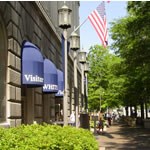
NPS White House Visitor CenterThe White House Visitor Center is operated by the National Park Service and is located at the north end of the Department of Commerce Building in Malcolm Baldrige Hall, originally called the Great Hall. Mr. Baldrige was Secretary of Commerce from 1981 to 1985 during Ronald Reagan's presidency. Construction of the Commerce building began on October 4, 1927, when Herbert C. Hoover was the Secretary of Commerce. The cornerstone was laid on July 10, 1929, when Hoover was President, and the building was completed in 1932. The Great Hall, 225 feet long and 62 feet wide, was originally used as the Patent Search Room for more than three million patents catalogued by the Department of Commerce. In celebration of our country's two hundredth birthday, the Hall became the Bicentennial Visitor Center in 1976. Until 1989, it housed the Washington Tourist Information Center. Renovations began in July 1993 with the restoration of the ornate plaster ceiling. The intent was to restore the simple elegance of the Great Hall. The original Indiana limestone walls, bronze doors, Vermont marble base and accent flooring, and Italianate bronze chandeliers were cleaned and refurbished. The visitor center opened in March 1995. It is designed to offer a welcoming experience and provide visitors with history and information on the White House and President's Park. The museum was renovated with updated exhibits in 2014. 
NPS General Sherman StatueThis monument consists of a bronze equestrian statue of Civil War General William Tecumseh Sherman (1820-1891) and a square platform with a bronze soldier at each corner, representing the four branches of the U.S. Army: infantry, artillery, cavalry, and engineers. President Theodore Roosevelt dedicated the monument on October 15, 1903. This site was chosen because General Sherman was reported to have stood here while reviewing returning Civil War troops in May 1865. Relief medallions of generals who served under Sherman's command are located on the east and west sides of the granite pedestal. Around the base of the pedestal's terrace is a mosaic inlaid with the names of battles in which Sherman fought. 
NPS U.S. Department of the TreasuryTwo treasury buildings already had been lost to fire when this site was chosen in 1836 for a new fireproof building near the ruins. The building's east wing, designed by Robert Mills, architect of the Washington Monument, was completed in 1842. The south wing was completed in 1860. The design for the south and west wings was provided by Thomas Ustick Walter, architect of the U.S. Capitol dome, but architects Ammi Young and Isaiah Rogers designed the interior details and supervised construction. The final addition, the north wing, was designed by Alfred Mullett. The Treasury Building served as a barracks for soldiers during the Civil War and as a temporary White House for President Andrew Johnson following the assassination of President Abraham Lincoln in 1865. The building's most impressive feature is the east colonnade, running the length of the building. Each of the thirty columns is 36 feet tall, and is carved from a single block of granite. A statue of Alexander Hamilton, the first Secretary of the Treasury, is located on the south side of the building. Hamilton was killed in a duel with Vice President Aaron Burr in 1804. A statue of Albert Gallatin of Pennsylvania, Secretary of the Treasury from 1801 to 1814, is located on the north side of the building. 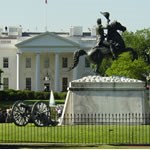
NPS Lafayette ParkThe seven acre Lafayette Park is directly north of the White House. Historically, the land that comprises Lafayette Park has been used as a race track, a showplace for caged animals, a graveyard, a slave market, and an encampment for soldiers, as well as for many political protests and celebrations that continue today. The park was planned by architect Charles Bulfinch in 1821, and upon completion several years later, it was named for the first foreign guest of state to stay at the White House, General Marquis de Lafayette. Originally named Lafayette Square, it was once a prime residential address. Many important residents included Vice Presidents, members of Congress, and foreign ambassadors. Naval hero Stephen Decatur's and former first lady Dolly Madison's houses still stand. The park has a rich history with St. John's Church, often referred to as the "Church of the Presidents." Where the Treasury Annex stands was once of the Freedman's Bank, of which Frederick Douglass was a director. By the 20th century the park was known as Lafayette Park. The present park design was created by John Carl Warneke in the 1960s. The historic efforts of President and Mrs. John F. Kennedy, in the 1960s, led to the preservation of the park and the buildings surrounding it. The area was designated a National Historic Landmark in 1970. 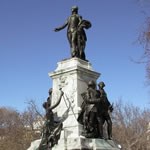
NPS General Lafayette StatueThis memorial was erected in 1891 on the southeast corner of Lafayette Park. Some believe the bronze statue portrays the Marquis de Lafayette (1757-1834) petitioning the French National Assembly for assistance to the Americans in their fight for independence. He stands on a marble pedestal facing south, wearing a military uniform and carrying a sword. On the south pedestal face, a bronze female figure, symbolizing America, turns toward him and imploringly lifts a sword. Lafayette was a wealthy nineteen-year-old nobleman when he sailed his own vessel, la Victoire, to America in 1777. He sought glory as a soldier and contributed a large sum of his own money to the Americans. He was appointed a major general in the Continental army and served under General George Washington. He was wounded at Brandywine, shared the winter hardships at Valley Forge, and was a key strategist in the Yorktown campaign that led to the British surrender. Lafayette was the first foreign dignitary to address Congress in 1824, and on his death in 1834, both the House and Senate draped their chambers in black. Congress bestowed honorary citizenship on Lafayette in 2002. 
NPS General Kosciuszko StatueThe statue commemorates Polish patriot Thaddeus Kosciuszko (1746-1817) and his life-long dedication to fighting for freedom in America and Poland. His skill in building fortifications in key places, including West Point, contributed greatly to the success of freedom in the American Revolution. This bronze memorial, located at the northeast corner of Lafayette Park, was dedicated in 1910. The figure of Kosciuszko, on a granite pedestal, wears the uniform of a general of the Continental Army and his right hand holds a map of the fortifications of Saratoga, New York. Directly below Kosciuszko stands a defiant eagle with outspread wings. The eagle is guarding a flag, a shield, and a sword upon a portion of the globe showing America. On the opposite side is an eagle struggling fiercely with a snake atop a portion of the globe showing Poland. 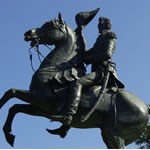
NPS General Jackson StatueThis monument, located in the center of Lafayette Park, portrays Major General Andrew Jackson (1767-1845) as he appeared while reviewing his troops at the Battle of New Orleans, Louisiana, on January 8, 1815. Thirteen years later he became the seventh president of the United States. The bronze statue faces west, while Jackson and his charger look slightly south toward the White House. Grouped at the base are four of the cannons Jackson captured in Pensacola, Florida. These four are rare pieces cast by Josephus Barnola at the royal foundry in Barcelona, Spain, and are named El Aristeo (1773), El Apolo (1773), El Witiza (1748), and El Egica (1748) for Greek gods and Visigoth kings. The sculptor erected a studio and furnace near the proposed site in 1849. He had to make six castings of the horse before the final casting was completed in December, 1852. The entire statue was cast in ten pieces, four of the horse and six of Jackson, for a total weight of 15 tons. The statue, the first in the park, was dedicated on January 8, 1853, on the thirty-eighth anniversary of the Battle of New Orleans. 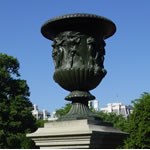
NPS Navy Yard UrnsThese five-foot high, four-foot wide ornamental bronze urns were cast here in Washington at the Navy Yard using melted cannon from the Civil War. The Ordinance Department of the U.S. Navy crafted them, and they were erected in Lafayette Park in 1872. They were presented by Secretary of the Navy George Robeson. The urns were included in the 1852 plans for the park by renowned landscape architect Andrew Jackson Downing. Originally these urns were placed on granite pedestals and located in the center of two flower beds east and west of the Jackson statue. In 1936, the urns were relocated within the park at the center of Jackson Place and Madison Place, and relocated to their present location in 1969. 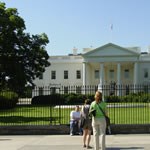
NPS White House North LawnJohn Adams, our second president, was the first president to live in the White House. The first president, George Washington, oversaw construction, but never lived here. Washington chose Irish-born and trained architect James Hoban to build the sandstone residence. Construction began in 1792 and was completed in 1800. The White House was the largest residence in the United States until after the Civil War. It has been expanded, renovated, repaired, and repainted many times in the last two hundred years. British troops burned the White House in 1814 during the War of 1812. Although the fire was put out by a summer thunderstorm, all that remained were the charred outside walls and the interior brick walls. President James Madison brought Hoban back to rebuild the mansion, and it was completed in three years. During the nineteenth century, the grounds on the north side were open every day. Tourists and business callers walked up a fenced driveway and entered as they might enter any friend's house. President Lincoln delivered several memorable speeches from the window over the main door, with thousand listeners crowded below. The fountain was added by President Ulysses S. Grant in the mid-1870s. Today, it is surrounded by colorful plantings seasonally, including tulips in the spring, red salvia in the summer, and mums in the fall. As the United States became more prominent in world affairs and the role of the presidency expanded, the White House needed to grow. In 1902, the West Wing was added to the White House. In 1909, the wing was expanded, and an oval office was added. In 1934, the West Wing was expanded again, and the current Oval Office, the president's office, was located on the south side of the West Wing. The East Wing was built in 1942. Traditionally, the first lady's offices are located in this area. The northwest corner of the North Lawn is used by the news media reporting national and international news. 
NPS Baruch Bench of InspirationBernard Baruch (1870-1965), a financial advisor from New York City, made his fortune on Wall Street. His greatest satisfaction, however, was his service to his country as an economic advisor during World War I and World War II and as a confidante to six presidents. The story is told that Mr. Baruch disliked being driven to the White House to confer. He preferred to sit on a bench and wait for a signal light from the White House indicating that the president was ready to meet with him. He was so well-known in this role that he was dubbed "the Park Bench Statesman," and once received a letter addressed simply, "Bernard Baruch, Lafayette Park, Washington, D.C." A commemorative bench with a bronze plaque set in granite block was dedicated on August 16, 1960, Baruch's ninetieth birthday. The bench is located just northwest of the Jackson statue. 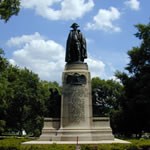
NPS General von Steuben StatueThis memorial portrays Baron Friedrich Wilhelm von Steuben (1730-1794) as he inspected American troops at the great maneuvers of 1778 during the American Revolution. His experiences as a General staff member in the Prussian army gave him a wealth of knowledge unheard of in the British and French armies of the period. This training eventually brought to the American soldiers the technical knowledge necessary to create an army. During the winter of 1778-9, von Steuben prepared the "Regulations for the Order and Discipline of the Troops of the United States." He also established a standard of sanitation and camp layouts that would remain a standard a century and a half later. Today he is known as the "Father of Military Instruction." After his discharge from the army on March 24, 1784, he became an American citizen and was granted sixteen thousand acres of land by the state of New York. Today, this land, including the town of Steubenville, is located in central New York. 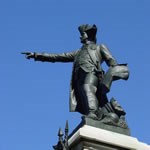
NPS General Rochambeau StatueComte de Rochambeau (1725-1807) commanded the 5,500-man Royal French Expeditionary Force sent to help the American revolutionary forces from 1780 to 1782. His skillful leadership and professional wisdom were vital to the American victory at Yorktown in 1781. The statue depicts him directing his troops. Rochambeau is wearing the uniform of France. He was the "official" representative of the King of France. A female figure, Liberty, raises two flags in her left hand, symbolizing the unity of France and America. She grasps a sword in her right hand as she prepares to defend an embattled eagle symbolizing America. The eagle, with its right talon, grasps a shield with thirteen stars symbolizing the thirteen colonies, while it fends off aggressors with its left talon. This sculptural group on the southwest corner of Lafayette Park was dedicated in 1902 by President Theodore Roosevelt. Learn more about the history of the Rochambeau Statue. 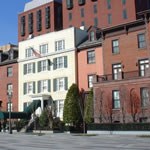
NPS / Michael D. Moreno Blair-Lee HouseBuilt in 1824 for Dr. Joseph Lovell, first surgeon general of the United States, this National Historic Landmark serves as the official guest house of the president. It was the second private residence built near Lafayette Square. In 1836, both Dr. Lovell and his wife died. The house was purchased by Francis Preston Blair, a member of President Andrew Jackson's "kitchen cabinet" and co-publisher of the newspaper The Globe. In 1852 the Blairs constructed a house next door for their only daughter, Elizabeth Preston Blair, who had married Samuel Phillips Lee in 1843. The tow houses began to be used as one; this continues today. William Tecumseh Sherman was married at the house in 1850. Also in this house Robert E. Lee was offered command of the Union army, which he turned down in favor of the Confederate army. Francis Blair's grandson, Gist Blair, contributed major renovations to Blair-Lee House. When he died in 1940, he expressed in his will a desire that the house be preserved and used as a residence. The house became the president's official guest house in late 1942, during the presidency of Franklin Delano Roosevelt. During the renovation of the White House from 1948 to 1952. President Harry S Truman and his family lived in Blair-Lee House. In 1951, President Truman survived an assassination attempt. One member of the president's Secret Service detail was killed and a memorial plaque on the fence acknowledges the agent's sacrifice. Many foreign heads of state stay at Blair-Lee House when visiting the President. The flag of the visiting dignitary's country flies from Blair-Lee House during a state visit. 
NPS Eisenhower Executive Office BuildingThe Dwight D. Eisenhower Executive Office Building was built between 1871 and 1888 to house the growing staffs of the State, War, and Navy Departments. The first electric lights were installed in its corridors in 1893. Telephone service became available between 1900 and 1902. The Department of Navy and War merged into the Department of Defense and moved into the Pentagon in the 1940s. By 1949, the Department of State had moved into its new headquarters, and the building was renamed the Executive Office Building. Among the "firsts" that occurred in this building; On January 19, 1955, President Eisenhower held the first televised presidential press conference in the building and in 1995, the White House web site was officially unveiled here. Renamed again by Congress in 1999 to honor the thirty-fourth president, the building today houses various agencies that make up the Executive Office of the President, including the Office of the Vice President, the Office of Management and Budget, and the National Security Council. EllipseExplore the Southern Trail |
Last updated: July 19, 2025
